
PREV ARTICLE
NEXT ARTICLE
FULL ISSUE
PREV FULL ISSUE
SELECTIONS FROM THE POGUE COLLECTION, PART IV
Below is a note from cataloguer John Kraljevich's introduction to Part IV of the Stack's Bowers sale of the D. Brent Pogue
Collection. Following that are some coins that caught my eye in the online listings. Thanks to Saul Teichman for the heads' up that
the lots are now online. -Editor
With some sadness, this catalog ends the presentation of the half dollars and half eagles of the D. Brent Pogue Collection. These denominations formed the heart and soul of the cabinet. The half eagles, in particular, are easy to access as the finest such grouping ever assembled. Before this catalog, there was only one living numismatist who had ever cataloged an 1822 half eagle. It’s humbling to become the second name on the list. The silver dollars herein, though few in number, pack perhaps the greatest punch, coin-for-coin, of any selection of the series ever offered. The intricacy and intensity of the day-by-day production of this work would not have been possible without the synergistic help of Stacks Bowers Galleries employees in three different offices, as well as the aid of my wife and family here in South Carolina. Late night texts from California to confirm a provenance, mid-afternoon assurances that the home front was under control, and early morning access to the vault on 57th Street are contributions that will never be described in the pages of a catalog, but they were nonetheless vital and appreciated. The Pogue Collection was formed to be enjoyed by others, but also because of an individual’s love of numismatics. This catalog was written the same way. I hope you enjoy it. For more information on the sale, please contact Christine Karstedt at ckarstedt@stacksbowers.com. Lot 4001; Proof 1836 Reeded Edge Half Dollar
 
“I have the pleasure to send you herewith, and to beg you to exhibit to the President, the first specimens of our coinage of silver by steam, executed this afternoon.” — Mint Director Robert M. Patterson to Secretary of the Treasury Levi Woodbury, November 8, 1836 The introduction of steam power to the coining process represented the single greatest technological watershed in the history of the United States Mint. Though later changes to hydraulic and electric power made coinage successively faster and increased the Mint’s capacity, no other advance could match the change from mills powered by horses and presses powered by men to the neat mechanized efficiency of steam. When steam power was first connected to a press, United States coinage first became fully automated; when this coin was struck, the effort to mechanize the Mint was finally complete. The first 1836 Reeded Edge half dollars were struck on Election Day, the second Tuesday of November 1836. Mint Director Robert M. Patterson was described in an 1854 biography by Samuel Breck as an adherent of “the Jeffersonian or Democratic school,” though moderate enough that no Whig tried to displace him from office. Given his political affiliation, Patterson probably visited the polls in Philadelphia and cast a vote for Martin Van Buren, the Democratic nominee, soon to be the President-elect. In the afternoon, Patterson sat down to write a letter to another Democrat, Levi Woodbury, who served as Secretary of the Treasury in Andrew Jackson’s administration and would remain in the position under President Van Buren. The letter enclosed the fruits of what must be counted as one of the most important days in the history of the United States Mint. To read the complete lot description, see:
Lot 4007; 1838-O Capped Bust Half Dollar
 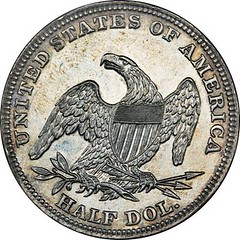
“They are not merely among the rarest Mint Marks, but the rarest pieces of United States coinage” — Augustus Heaton, A Treatise on the Coinage of the United States Branch Mints, 1893 There is a short list of American coins whose rarity and legend need no introduction. Among half dollars, there is only one of these signal rarities: the 1838-O. The story of its genesis coincides with that of the New Orleans Mint, the first branch mint to strike silver coinage. Just 20 are thought to have been struck, and only nine are known to have survived to the present day. Strictly judged on the merits of such a tiny population, this would be a famous and special issue, but its history and special production gives the 1838-O half dollar further layers of desirability. Like all 1838-O half dollars, this coin was specially struck to accentuate its detail, coined with a finish to make it stand out among other half dollars of its type. Today, the 1838-O halves are called “Specimens,” a modern term to acknowledge their distinctive minting procedure and texture, though in the past they have often been called Branch Mint Proofs. The fields are reflective, displaying a handcrafted surface that is neither frosty like typical half dollars of this era struck for circulation, nor mirrored like Proof half dollars coined in Philadelphia for presentation or sale to collectors. From this smooth surface, the devices stand out with exceptional boldness. Each star not only has central detail, its angles are taut and its points are sharp. The portrait of Liberty is presented in rounded, sculptural relief; her hair is engraved with the fineness of terracotta incised with a reed while still wet. The denticles are individually formed and stand apart from the rim. The reverse shows every engraved contour of the eagle, from beak to talons, a textbook on how this design type would look if the engraver’s sketch became manifested into metallic reality. The strike was so forceful as to create a wire rim, called a “fin” in the mint terminology of the era; seen as a striking imperfection by the coiners of that time, the fin was diminished before release, but is still somewhat visible around the reverse. To read the complete lot description, see:
Lot 4012; “Proof” Garrett 1795 Draped Bust Dollar
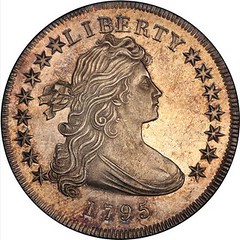 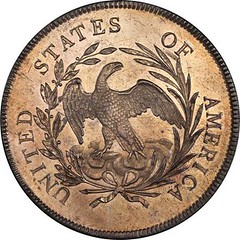
“This beautiful dollar, so far as condition is concerned, Mr. Randall declares is unique. I certainly have never seen one approaching it in perfection and beauty.” — W. Elliot Woodward, 1885 J. Colvin Randall’s eye for quality was renowned during his long association with numismatics. He flourished from the 1860s until the 1890s, but the June 1885 sale of his collection is the event for which he is most remembered today. Randall’s name had been on many catalog covers before, but the W. Elliot Woodward sale of his cabinet contained his choicest pieces. The sale is given John W. Adams’ highest rating, A+; he comments that Randall’s “complete regular mint series” was the “best ever for condition,” including a “Proof 1795 $1.” This coin was one of three early dollars in a row across the top of the photographic plate that opposed the catalog’s title page. Woodward’s preface made clear that while Randall had been a dealer for years, he had also been a collector who “made it a constant practice to reserve the finest and rarest pieces which have fallen into his hands during all this period, until his collection is now unrivaled in those specialties to which he has given particular attention, notably the gold coins and the larger coinage of silver.” Describing his quality connoisseurship, Woodward wrote “Mr. Randall, however good a specimen he might possess, was never content if a better one existed until he became its possessor, and as a whole, the collection cannot be surpassed for fineness of quality. Collectors will not fail to notice such examples as the brilliant proof 1795 fillet head dollar.” The sale led off with his famous collection of silver dollars. This coin, selling as lot 12, brought $113, exactly $100 more than the Uncirculated 1795 Flowing Hair dollar in lot 11 and almost exactly double the $67 achieved by lot 1, a 1794 dollar described as “uncommonly fine.” Randall’s greatest prize was acquired by T. Harrison Garrett, who was represented at the Randall sale by Harold P. Newlin. A week before the sale, on June 23, 1885, Newlin suggested a $200 bid on the 1795 dollar to Garrett. A few days after the sale, reporting on his successes, Newlin’s estimate increased: “The fillet head 1795 is worth $300.” The question was academic, as it wasn’t for sale. It would remain in the Garrett Collection for 95 years, until 1980. To read the complete lot description, see:
Lot 4026; 1822 Half Eagle
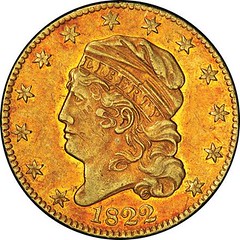 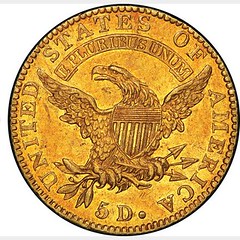
“I have the only one not in the hands of the government.” — Louis Eliasberg, on the 1822 half eagle, 1975 The turning point in the story of the 1822 may have been the 1890 Parmelee sale. Lorin Parmelee collected the greatest cabinet of United States and colonial coins ever assembled in 19th century America. Parmelee not only bought individual coins wherever he could find them, but he bought entire collections to get upgrades and issues he lacked. The collections he bought en bloc included some of the greatest numismatic cabinets of his era, like those of George A. Seavey, J. Carson Brevoort, and Charles I. Bushnell. Seavey’s collection of gold coins was considered complete as early as 1864. When the time came for Parmelee to auction his holdings, he was undoubtedly horrified to find that his 1822 was a counterfeit. In order to maintain the integrity of the cabinet, Harlan Page Smith, a principal of the New York Coin and Stamp Company, inserted his own coin into the collection, though he had no intent to sell it. It was cataloged with a casualness that stood out amidst the spare prose of the rest of the Parmelee lots, called “awfully rare from way back” and correctly characterized as “the first and only one ever offered at public sale.” Smith bought the coin back for $900, and it remained his until his death in 1902. By the time his collection was sold by the Chapman brothers in 1906, numismatists had finally grown aware of the date’s extraordinary rarity. Specialized numismatic auctions had, at that point, been commonplace for a half century, yet not one of them had ever included a genuine 1822 half eagle. Smith was fond of telling the story of his coin’s discovery, plucked from a bullion dealer’s stock for $6.50. When it sold in the auction gallery of Davis and Harvey, Auctioneers, at 1112 Walnut Street in Philadelphia on May 8, 1906, it realized $2,165, a record. “1804 dollars must now take a back seat,” reported The Numismatist soon thereafter. “An 1822 half eagle at the Harlan P. Smith sale in Philadelphia brought $2,165.” The winning bidder, William Forrester Dunham of Chicago, already had an 1804 dollar, but his 1822 half eagle was his greatest prize. To read the complete lot description, see:
To read the complete cataloguer's introduction, see:

Wayne Homren, Editor The Numismatic Bibliomania Society is a non-profit organization promoting numismatic literature. See our web site at coinbooks.org. To submit items for publication in The E-Sylum, write to the Editor at this address: whomren@gmail.com To subscribe go to: https://my.binhost.com/lists/listinfo/esylum All Rights Reserved. NBS Home Page Contact the NBS webmaster 
|